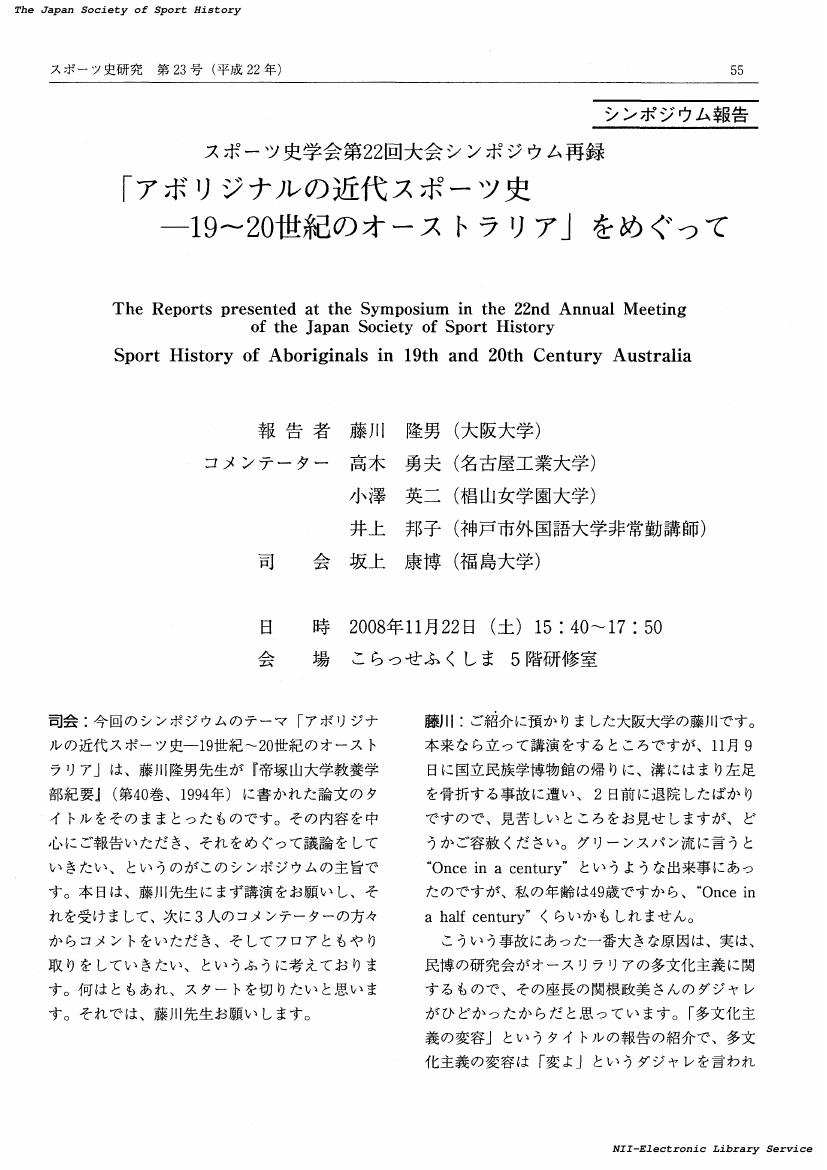- 著者
- 井上 邦子
- 出版者
- Japan Society of Sport Anthropology
- 雑誌
- スポーツ人類學研究 (ISSN:13454358)
- 巻号頁・発行日
- vol.2002, no.4, pp.1-16, 2003-03-31 (Released:2011-08-16)
- 参考文献数
- 35
They hold the horse racing in “_??_ (caGan sara) ” -New Year's festival in the old calendar and sometimes hold it for the tourism. Among these horse racing, it is the most popular that held in Naadam-festival the traditional summer festival with the horse racing, Mongolian-style wrestling and the archery in Mongolia.In a case of the horse racing in the national Naadam-festival at a capital, Ulan Bator, about 400 horses are entered for the race, the riders are children from 5 to 12 years old. The horses are classified according to their age, and run a race from10 to 30km. The horses are gathered at the goal point at first, then a herd of the horses are moved to the start point at a trot. Finally, they turn in that place, and come running back the goal point. The best five horses are named “the five of _??_ (ayiraG) ” - “a _??_ p _??_ _??_” is the liquor made from milk of horses-, they are blessed and are poured “_??_” on their back.At present, they held the horse racing as “the sports festival of nation”. The horse racing, however. has the aspects of the ritual, originally. The former researchers have interpreted the horse racing of Naadam games as “_??_ (obu) -festival” -the ritual for worship of the earth-or the ritual of sacrifice. It is true that Naadam-festival is held for “the sports festival of nation” nowadays, but, I think the element of the ritual in Mongolian horse racing is kept in Mongolian people feeling toward race horses, because they worship the racehorses as the especially animal. The racehorses are the objects of belief in Mongolia, because they are buried at “_??_ (obu) -mound” that is for worship of the earth, when they died.By the way, many case studies of holy animal reported from every corner of the world. But the aspect of holy may vary with the context in which the animal live. If that is the case, how do I grasp the concept of holy towards the racehorses in Mongolia?I examine this paper as follows; (1) making clear about horse culture in Mongolia and horse racing in Naadam-festival (2) report about the skill to select and train the racehorses (3) studying about the aspect of racehorses holy.By the way, I study this paper on the basis of the data for six times field works from 1995 July to 1998 July.In the first place, the nomads in Mongolia think the horse have closer relationship with human being than the other domestic animals. Based on the horse culture above mentioned, “y _??_ a q _??_ _??_ (uyaGCin) ”, he is a technical nomad keeping the racehorses, trains the horses most effectively according to the lineage and the character of each horse. For example, “_??_ (uyaGcin) ” gives the text of a sutra, “_??_ (geyin Goo) ” to the horses, and furthermore, he takes care of the horse by the special cloth for courtesy. After that, the simple horse becomes the racehorse. When the training succeed in this way, it gives full play to the racehorse's ability, and they thought the racehorse is given the holy.Interestingly holy of racehorse given by the skill of “_??_ (uvaGcin) ” doesn't maintain. The race-horse is put out to grass like the others domestic animals again after the Naadam-festival. This shows the fact that there is “holy cycle of racehorse”, they have their own way of training and giving holy to the horse on the basis of traditional view of Mongolian nomads. Accordingly, I think the racehorse may be defined as the animal for sacrifice while being alive at present.In current Mongolia, holy of the racehorse still exists through Naadam-festival, which is placed as the national sports
